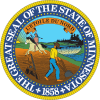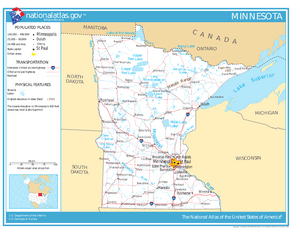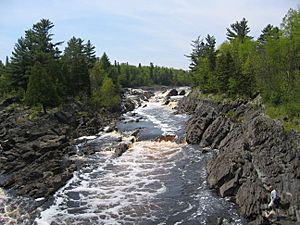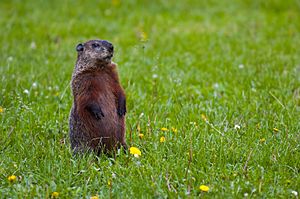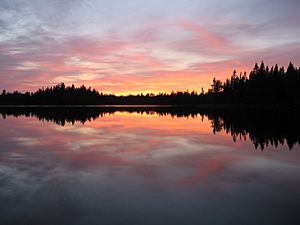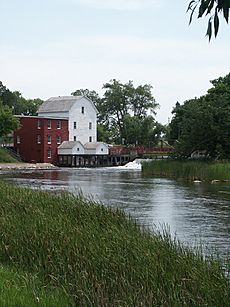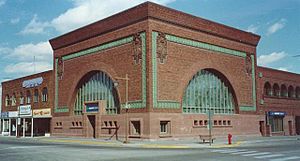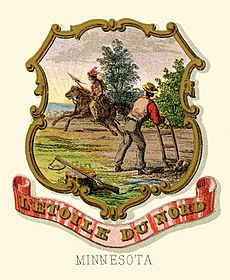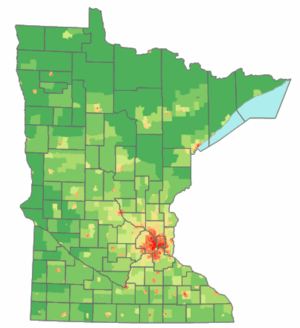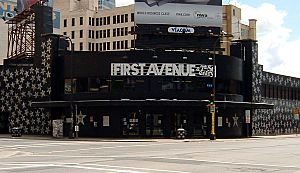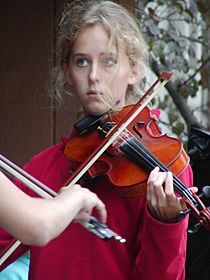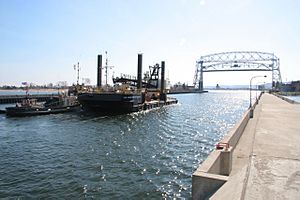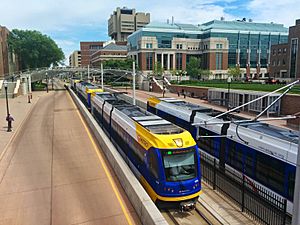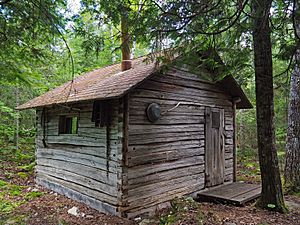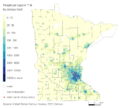Minnesota facts for kids
Quick facts for kids
Minnesota
|
|||
|---|---|---|---|
|
|||
| Nicknames:
North Star State; Gopher State; Land of 10,000 Lakes; Land of Sky Blue Waters;
|
|||
| Motto(s):
L'Étoile du Nord (French: The Star of the North)
|
|||
| Anthem: "Hail! Minnesota" | |||

Location of Minnesota within the United States
|
|||
| Country | United States | ||
| Before statehood | Minnesota Territory | ||
| Admitted to the Union | May 11, 1858 (32nd State in the Union) | ||
| Capital | Saint Paul | ||
| Largest city | Minneapolis | ||
| Largest county or equivalent | Hennepin | ||
| Largest metro and urban areas | Minneapolis–Saint Paul | ||
| Legislature | Legislature | ||
| • Upper house | Senate | ||
| • Lower house | House of Representatives | ||
| Judiciary | Minnesota Supreme Court | ||
| U.S. senators | Amy Klobuchar (DFL) Tina Smith (DFL) |
||
| U.S. House delegation | 4 Democrats 4 Republicans (list) |
||
| Area | |||
| • Total | 86,935.83 sq mi (225,163 km2) | ||
| • Land | 79,626.74 sq mi (206,232 km2) | ||
| • Water | 7,309.09 sq mi (18,930 km2) 8.40% | ||
| Area rank | 12th | ||
| Dimensions | |||
| • Length | about 400 mi (640 km) | ||
| • Width | 200–350 mi (320–560 km) | ||
| Elevation | 1,200 ft (370 m) | ||
| Highest elevation | 2,301 ft (701 m) | ||
| Lowest elevation | 602 ft (183 m) | ||
| Population
(2024)
|
|||
| • Total | |||
| • Rank | 22nd | ||
| • Density | 68.9/sq mi (26.6/km2) | ||
| • Density rank | 36th (2020 census) | ||
| • Median household income | $85,100 (2023) | ||
| • Income rank | 13th | ||
| Demonym(s) | Minnesotan | ||
| Language | |||
| • Official language | none | ||
| • Spoken language | |||
| Time zone | UTC– 06:00 (Central) | ||
| • Summer (DST) | UTC– 05:00 (CDT) | ||
| USPS abbreviation |
MN
|
||
| ISO 3166 code | US-MN | ||
| Traditional abbreviation | Minn. | ||
| Latitude | 43° 30′ N to 49° 23′ N | ||
| Longitude | 89° 29′ W to 97° 14′ W | ||
| Bird | Common loon |
|---|---|
| Fish | Walleye |
| Flower | Pink-and-white lady's slipper |
| Tree | Norway pine (Pinus resinosa) |
Minnesota is a state located in the Upper Midwest region of the United States. It shares borders with Canada to the north and east. To the east, it borders Wisconsin, to the south, Iowa, and to the west, North Dakota and South Dakota. Minnesota is the 12th largest U.S. state by area. It is also the 22nd most populated, with about 5.8 million people.
Minnesota is famous as the "Land of 10,000 Lakes." It actually has 14,420 freshwater bodies that are at least ten acres in size. About one-third of the state is covered by forests. The rest is mostly prairie and farmland. More than 60% of Minnesotans live in the Minneapolis–Saint Paul area. This area is known as the "Twin Cities." It is the main center for politics, economy, and culture in Minnesota. Other important cities include Duluth, Mankato, and Rochester.
The name Minnesota comes from the Dakota language. Native American groups have lived here since ancient times. French explorers and missionaries were the first Europeans to arrive in the 1600s. They met the Dakota and Ojibwe tribes. Much of Minnesota was once part of a huge French territory called Louisiana. The United States bought this land in 1803. Minnesota became the 32nd U.S. state in 1858. Its official motto, L'Étoile du Nord ("The Star of the North"), is the only state motto in French. It shows the state's French history and its northern location.
As a part of the American frontier, Minnesota attracted many settlers. Its early growth came from timber, farming, and railroads. In the early 1900s, many immigrants arrived from Scandinavia, Germany, and Central Europe. Minnesota became a leader in workers' rights and political reform. Since the late 1900s, Minnesota's economy has grown beyond farming. It now includes services, finance, and health care. Minnesota has a high life expectancy and good income per person. The state is home to 11 Native American reservations. Its culture is shaped by Scandinavian and German influences. Recently, Minnesota has become more diverse. Many people have moved there from Latin America, Asia, and Africa.
Contents
- What's in a Name? The Meaning of Minnesota
- Exploring Minnesota's Geography
- A Look at Minnesota's History
- Major Cities and Towns in Minnesota
- How Minnesota's Government Works
- People and Culture of Minnesota
- Minnesota's Economy and Jobs
- Minnesota's Culture and Arts
- Getting Around Minnesota: Transportation
- Sports, Recreation, and Tourism in Minnesota
- Learning in Minnesota: Education
- Images for kids
- See also
What's in a Name? The Meaning of Minnesota
The word Minnesota comes from the Dakota language. It is the name the Dakota people gave to the Minnesota River. The river's name might mean "clear blue water" or "cloudy water." Early settlers learned the name from Native Americans. They showed them by dropping milk into water and calling it mnisota.
Exploring Minnesota's Geography
Minnesota is the second northernmost U.S. state, after Alaska. A small part of Minnesota, called the Northwest Angle, is the only part of the 48 connected states that lies north of the 49th parallel.
The state is part of the Upper Midwest region. It is also part of North America's Great Lakes Region. Minnesota shares a water border on Lake Superior with Michigan. It shares land and water borders with Wisconsin to the east. Iowa is to the south. North Dakota and South Dakota are to the west. The Canadian provinces of Ontario and Manitoba are to the north. Minnesota covers about 86,943 square miles (225,163 square kilometers). This makes it the 12th largest state.
How Minnesota's Landscape Was Formed
Minnesota has some of the oldest rocks on Earth. Some gneiss rocks are about 3.6 billion years old. That's 80% as old as the planet itself! About 2.7 billion years ago, hot lava flowed from cracks in the ancient ocean floor. The remains of this volcanic rock formed the Canadian Shield in northeast Minnesota.
More recently, huge ice sheets, at least one kilometer thick, shaped the state's land. The last glaciers left about 12,000 years ago. These glaciers covered almost all of Minnesota. Only the far southeast was left untouched. This area has steep hills and streams that cut into the rock. It is called the Driftless Zone because it has no glacial drift (rock and dirt left by glaciers).
Most of the rest of the state has 50 feet (15 meters) or more of glacial till. This was left behind as the glaciers melted. A giant lake called Lake Agassiz formed in the northwest 13,000 years ago. Its bed created the rich Red River valley. Its outflow, the glacial River Warren, carved the valley of the Minnesota River. Minnesota is very quiet geologically today. It rarely has earthquakes, and most are small.
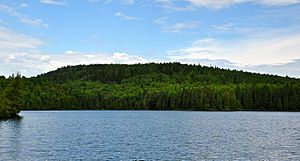
The state's highest point is Eagle Mountain at 2,301 feet (701 meters). This is only 13 miles (21 kilometers) from the lowest point, Lake Superior, at 601 feet (183 meters). Even with these differences, most of the state is gently rolling land.
Minnesota's nickname, "Land of 10,000 Lakes," is very true. There are 11,842 lakes over 10 acres (4 hectares) in size. The part of Lake Superior in Minnesota is the largest. It covers 962,700 acres (3,896 square kilometers) and is the deepest at 1,290 feet (393 meters). Minnesota has 6,564 natural rivers and streams. They flow for a total of 69,000 miles (111,000 kilometers).
The Mississippi River starts its journey at Lake Itasca. It flows 680 miles (1,090 kilometers) through Minnesota. It is joined by the Minnesota River and the St. Croix River. The Red River of the North drains the northwest part of the state. It flows north into Canada's Hudson Bay. Minnesota also has about 10.6 million acres (4.3 million hectares) of wetlands. This is more than any other state except Alaska.
Minnesota's Plants and Animals
Minnesota has four main natural areas. These are the Prairie Parkland, the Eastern Broadleaf Forest, the Tallgrass Aspen Parkland, and the Laurentian Mixed Forest. The northern forests are huge wilderness areas. They have pine and spruce trees mixed with birch and poplar.
Much of Minnesota's northern forest was logged in the past. Only a few areas of very old trees remain. Even though logging continues, new trees are planted. This keeps about one-third of the state forested. Most of Minnesota's prairies and oak savannas have been changed by farming and development.
Some native animals like the pine marten and elk have been affected by habitat loss. But others, like whitetail deer and bobcat, are doing well. Minnesota has the largest population of timber wolves outside of Alaska. It also has many black bears, moose, and gophers. The state is on the Mississippi Flyway. This means many migratory birds, like geese and ducks, visit. It is also home to birds of prey like bald eagles and red-tailed hawks. The lakes are full of fish like walleye, bass, and northern pike.
Minnesota's Weather and Climate
Minnesota has extreme temperatures. This is typical of its continental climate. Winters are cold, and summers are hot. The state experiences many types of weather. These include rain, snow, blizzards, thunderstorms, hail, and tornadoes.
Protecting Minnesota's Natural Beauty
Minnesota's first state park, Itasca State Park, was created in 1891. This park is where the Mississippi River begins. Today, Minnesota has 72 state parks and recreation areas. It also has 58 state forests, covering about four million acres (16,000 square kilometers). There are also many state wildlife preserves. All of these are managed by the Minnesota Department of Natural Resources.
A Look at Minnesota's History
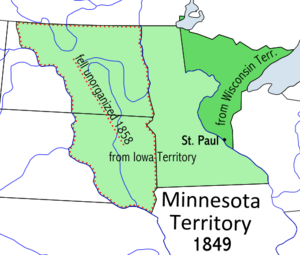
Before Europeans arrived, the Dakota people lived in Minnesota. As Europeans settled the East Coast, Native American groups moved west. This included the Anishinaabe (also called Ojibwe) who came to Minnesota.
French fur traders were the first Europeans here in the 1600s. Explorers like Daniel Greysolon, Sieur du Lhut and Louis Hennepin mapped the area. In 1762, the region became part of Spanish Louisiana. It remained so until 1802.
The part of Minnesota east of the Mississippi River became part of the United States after the American Revolutionary War. This happened with the Second Treaty of Paris. The land west of the Mississippi River was bought in the Louisiana Purchase.
In 1805, Zebulon Pike made a deal with Native Americans. He acquired land where the Minnesota and Mississippi rivers meet. Fort Snelling was built there between 1819 and 1825. Soldiers from the fort built a grist mill and a sawmill at Saint Anthony Falls. These were the first water-powered industries. The city of Minneapolis later grew around them.
The Minnesota Territory was formed on March 3, 1849. Many people came to build farms and cut timber. Minnesota became the 32nd U.S. state on May 11, 1858. Many of the first settlers came from New England. Because of this, the state was called "the New England of the West."
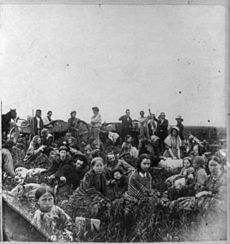
Agreements between European settlers and the Dakota and Ojibwe tribes slowly pushed Native Americans off their lands. They were moved to smaller reservations. In 1861, some people in Mankato formed a group called the Knights of the Forest. Their goal was to remove all Native Americans from Minnesota. As conditions worsened for the Dakota, tensions grew. This led to the Dakota War of 1862. After six weeks, 38 Dakota people were executed. Most of the remaining Dakota were sent away to the Crow Creek Indian Reservation. About 800 white settlers died during the war.
Logging and farming were very important to Minnesota's early economy. Sawmills at Saint Anthony Falls and logging centers like Stillwater processed huge amounts of lumber. These cities were on rivers, which were perfect for transportation. Later, Saint Anthony Falls provided power for flour mills. By 1900, Minnesota mills were grinding 14.1% of the nation's grain.
The state's iron-mining industry began in the 1880s. Iron was found in the Vermilion and Mesabi Ranges. In the early 1900s, iron was also found in the Cuyuna Range. The ore was sent by train to Duluth and Two Harbors. From there, it was loaded onto ships and sent east over the Great Lakes.
As industries grew, people moved from farms to cities in the early 1900s. But farming remained important. Minnesota's economy was hit hard by the Great Depression. Farmers got lower prices, iron miners lost jobs, and there were labor problems. To make things worse, western Minnesota and the Dakotas had a drought from 1931 to 1935. New government programs helped the economy recover. These programs created jobs for Native Americans on their reservations. The Indian Reorganization Act of 1934 gave tribes more self-government. This gave Native Americans a stronger voice in the state. It also led to more respect for tribal customs.
After World War II, industry grew even faster. New technology made farming more productive. Machines helped with raising animals and harvesting crops. University of Minnesota professor Norman Borlaug helped with these changes. Cities also grew rapidly as people moved to suburbs.
Minnesota became a center for technology after World War II. Companies like Engineering Research Associates and Medtronic started here. They developed computers and medical devices.
Major Cities and Towns in Minnesota
Saint Paul is in east-central Minnesota, along the Mississippi River. It has been Minnesota's capital city since 1849. First, it was the capital of the Minnesota Territory. Then, it became the state capital in 1858.
Saint Paul is next to Minnesota's largest city, Minneapolis. Together, they and their suburbs are called the Twin Cities. This metropolitan area is the 13th largest in the United States. About 60% of Minnesota's population lives here. The rest of the state is known as "Greater Minnesota."
Minnesota has 17 cities with more than 50,000 people (as of 2010). These include Minneapolis, Saint Paul, Rochester, Duluth, and Bloomington. Only Rochester, Duluth, and Saint Cloud are outside the Twin Cities area.
Minnesota's population continues to grow. Most of this growth is in the cities. The populations of Sherburne and Scott counties doubled between 1980 and 2000. But 40 of the state's 87 counties lost residents during the same time.
How Minnesota's Government Works
Minnesota is governed by its Minnesota Constitution. This was adopted on October 13, 1857, about a year before it became a state. Like the U.S. federal government, Minnesota has a republican system. Power is divided into three parts: executive, legislative, and judicial. The state constitution also has a bill of rights. This protects many of the same rights as the U.S. Bill of Rights.
The Governor and Executive Branch
The executive branch is led by Minnesota's governor. The governor is the chief executive. They appoint the heads of state agencies. They are also responsible for making sure laws are followed. The governor is the commander-in-chief of the Minnesota National Guard. A group of advisors, called the cabinet, helps the governor. This cabinet includes the lieutenant governor and the heads of 22 state agencies.
Besides the governor and lieutenant governor, Minnesotans also elect three other officials. These are the secretary of state, the attorney general, and the state auditor. These five officials form the Minnesota Executive Council. This council has duties related to state money, emergency management, and public lands.
The Legislature: Making Laws

The Minnesota Legislature has two parts: the Senate and the House of Representatives. The state has 67 districts. Each district has about 60,000 people. Each district elects one senator and two representatives. Each senatorial district is divided into "A" and "B" sections for House members. Senators serve for four years. Representatives serve for two years.
Since 2023, both the House and Senate have had a small majority of the Democratic–Farmer–Labor Party (DFL).
The Judicial System: Interpreting Laws
Minnesota's court system has three levels. Most cases start in the district courts. These courts handle many different types of cases. There are 279 district court judges in ten judicial districts. Appeals from these courts go to the Minnesota Court of Appeals. This court has 19 judges. They usually work in groups of three. The seven-justice Minnesota Supreme Court hears all appeals from the tax court and workers' compensation court. It also hears first-degree murder convictions. It can choose to hear appeals from the court of appeals. It also handles election disputes.
Two special courts are part of administrative agencies. These are the workers' compensation court of appeals and the tax court. The tax court handles non-criminal tax cases.
People and Culture of Minnesota
Minnesota's population grew from fewer than 6,120 white settlers in 1850 to over 1.7 million by 1900. By 1960, it reached 3.4 million. The 2020 census showed Minnesota's population at 5,709,752. This was a 7.65% increase since 2010. The state's population growth and age groups are similar to the national average.
In 2010, Minnesota's population was 5,303,925. About 49.6% were male and 50.4% were female. About 24.2% of the people were under 18.
Most Minnesotans are of European descent. Many have German, Norwegian, Irish, or Swedish backgrounds. In recent years, Minnesota has become more diverse. It has the largest Somali population in the country. It also has the second-largest Hmong community.
Religious Beliefs in Minnesota
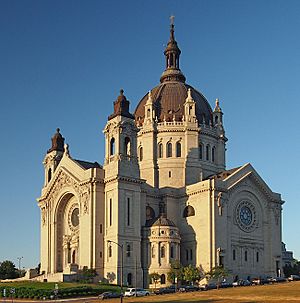
Most Minnesotans are Protestants. Many are Lutheran, due to the state's history with people from Northern Europe. Roman Catholics are the largest single Christian group. They often have German, Irish, French, and Slavic backgrounds.
A 2010 survey showed that 32% of Minnesotans were Mainline Protestants. 21% were Evangelical Protestants. 28% were Roman Catholic. Small numbers were Jewish, Muslim, or Buddhist. 13% said they had no religious affiliation.
Even though Christianity is most common, Minnesota has a long history with other faiths. The first Jewish synagogue in Saint Paul was set up in 1856. Minnesota is home to more than 30 mosques, mostly in the Twin Cities. The spiritual home of Eckankar is also in Minnesota.
Minnesota's Economy and Jobs
Minnesota's economy used to focus on raw materials. Now, it focuses on finished products and services. The economy is very diverse. Its business sectors are similar to the United States as a whole. In 2019, Minnesota's economy produced $383 billion. Many large companies are based in Minnesota. These include Target, UnitedHealth Group, 3M, and General Mills. Cargill, the largest privately owned company in the U.S., is also based here.
In 2019, the average income per person in Minnesota was $58,834. This was the 13th highest in the nation. The average household income was $74,593. This ranked 13th in the U.S.
Industries and Businesses in Minnesota
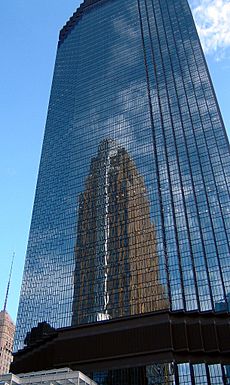
Minnesota's first industries were fur trading and farming. Minneapolis grew around the flour mills powered by St. Anthony Falls. Less than 1% of the population works in farming now. But it is still a big part of the state's economy. Minnesota ranks sixth in the nation for the value of farm products sold. The state is the largest producer of sugar beets, sweet corn, and peas for processing. It also produces many farm-raised turkeys.
Forestry is still strong. This includes logging, making paper, and wood products. Minnesota was known for its soft-ore mines. These produced a lot of the world's iron ore for over a century. The high-quality ore is mostly gone now. But taconite mining continues. This uses special processes developed in Minnesota to keep the industry going. In 2016, the state produced 60% of the country's usable iron ore. The mining boom created the port of Duluth. This port is still important for shipping ore, coal, and farm products.
The manufacturing sector now includes technology and medical device companies. It also has older food processors and heavy industries. The nation's first indoor shopping mall was Edina's Southdale Center. The largest is Bloomington's Mall of America.
Minnesota is one of 45 U.S. states with its own lottery.
Energy in Minnesota
Minnesota produces ethanol fuel. It was the first state to require its use, a 10% mix (E10). In 2019, over 411 gas stations sold E85 fuel. This fuel is 85% ethanol and 15% gasoline. A 2% biodiesel blend has been required in diesel fuel since 2005. Minnesota is one of the top ten states for wind energy. Nearly one-fifth of its electricity comes from wind.
Xcel Energy is the state's largest utility company. It is based in Minnesota. There are also many city-owned utility companies.
Taxes in Minnesota
Minnesota has a progressive income tax. This means people with higher incomes pay a higher percentage in taxes. The state sales tax is 6.875%. But clothing, prescription drugs, and food for home use are not taxed. The state legislature can allow cities to add local sales taxes. Taxes are also collected on alcohol, tobacco, and gas. Property owners pay property tax to their county, city, and school district.
Minnesota's Culture and Arts
Fine and Performing Arts in Minnesota

Minnesota has many great art museums. These include the Minneapolis Institute of Art, the Walker Art Center, and the Frederick R. Weisman Art Museum. All of these are in Minneapolis. The Minnesota Orchestra and the Saint Paul Chamber Orchestra are professional music groups. They perform concerts and offer educational programs. The famous Guthrie Theater moved into a new building in Minneapolis in 2006. It has three stages and overlooks the Mississippi River. Many people in the Twin Cities go to plays, concerts, and comedy shows. The Twin Cities have more theater seats per person than any U.S. city except New York City. About 2.3 million theater tickets are sold each year. The Minnesota Fringe Festival is a yearly event. It celebrates theater, dance, music, and art. It is the largest festival of its kind in the United States.
Literature from Minnesota
Stories about pioneer life on the prairie are found in Giants in the Earth by Ole Rolvaag. The Little House series by Laura Ingalls Wilder also tells these tales. Small-town life is shown in Sinclair Lewis's novel Main Street. Garrison Keillor writes about it more kindly in his stories of Lake Wobegon. St. Paul native F. Scott Fitzgerald wrote about the city in stories like Winter Dreams. Henry Wadsworth Longfellow's poem The Song of Hiawatha was inspired by Minnesota. Minnesota native Bob Dylan won the 2016 Nobel Prize in Literature.
Entertainment and Pop Culture
Many famous musicians are from Minnesota. These include Bob Dylan, Eddie Cochran, The Andrews Sisters, and Prince. Minnesotans have helped shape American music. The Andrews Sisters' "Boogie Woogie Bugle Boy" was a famous song during World War II. Prince was a huge music star in the 1980s.
The comic strip Peanuts was created by St. Paul native Charles M. Schulz.
Filmmakers like Joel and Ethan Coen and Terry Gilliam are from Minnesota. Many actors are also from the state. These include Judy Garland, Jessica Lange, and Chris Pratt.
Minnesotans are often known for being "Minnesota nice." They also have a strong sense of community. They have a unique way of speaking English, with some Scandinavian words.
Potlucks are popular church activities in small towns. They usually have many different "hotdishes" (casseroles). Some people celebrate Christmas with a traditional lutefisk dinner.
Life in Minnesota is shown in movies like Fargo, Grumpy Old Men, and Juno. It's also seen in TV shows like Little House on the Prairie and The Mary Tyler Moore Show. Many movies have been filmed in Minnesota. These include Purple Rain and The Mighty Ducks films.
The Minnesota State Fair is a huge event. It is called The Great Minnesota Get-Together. In 2014, over 1.8 million people visited the fair. It shows all parts of Minnesotan life. This includes art, science, farming, food, music, and rides. It is famous for its "seed art" and butter sculptures. You can also find many foods on a stick! Smaller versions of these attractions are at county fairs.
Other big yearly festivals include the Saint Paul Winter Carnival and the Minnesota Renaissance Festival.
Getting Around Minnesota: Transportation
Transportation in Minnesota is managed by the Minnesota Department of Transportation (MnDOT). Local governments also help. Major roads spread out from the Twin Cities area. The main Interstate highways are I-35, I-90, and I-94. I-35 and I-94 connect the Minneapolis–St. Paul area. I-90 goes east-west along the southern edge of the state. In 2006, a new law was passed. It said that taxes on cars must help fund transportation. At least 40% must go to public transit.
There are almost two dozen rail lines in Minnesota. Most go through Minneapolis–St. Paul or Duluth. Water transportation is available on the Mississippi River and from the ports on Lake Superior.
Minnesota's main airport is Minneapolis–St. Paul International Airport (MSP). It is a major hub for Delta Air Lines and Sun Country Airlines. Large commercial flights also go to Duluth and Rochester. Smaller cities have commuter flights.
Public transit is available in Minnesota's cities. Metro Transit serves the Twin Cities. Other cities like Duluth and Mankato also have bus systems.
Amtrak's Empire Builder train runs through Minnesota daily. It stops at the Saint Paul Union Depot and five other stations. Intercity bus companies also serve the state. Local public transit includes bus networks and two rail services. The Northstar Line commuter train runs from Big Lake to downtown Minneapolis. From there, light rail connects to Saint Paul and the airport.
Sports, Recreation, and Tourism in Minnesota
Minnesota has many organized amateur and professional sports. Tourism is also an important industry. This is especially true in the Lake region. The northern part of the state, once focused on mining, is now a popular vacation spot. Many people enjoy outdoor activities like hunting and fishing.
Professional and College Sports
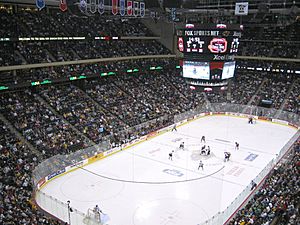
Minnesota has professional men's teams in all major sports.
- The Minnesota Vikings have played in the National Football League (NFL) since 1961. They now play in U.S. Bank Stadium. This stadium hosted Super Bowl LII in 2018.
- The Minnesota Twins have played in Major League Baseball (MLB) in the Twin Cities since 1961. They won the World Series in 1987 and 1991. The team plays at Target Field.
- The Minnesota Timberwolves joined the National Basketball Association (NBA) in 1989. They play in Target Center.
- The National Hockey League's Minnesota Wild play in St. Paul's Xcel Energy Center.
- Minnesota United FC joined Major League Soccer (MLS) in 2017. The team plays at Allianz Field in St. Paul.
Minnesota also has minor-league professional sports teams. The St. Paul Saints are a Triple-A baseball team. They are linked to the Minnesota Twins.
Professional women's sports teams include the Minnesota Lynx of the Women's National Basketball Association. They won championships in 2011, 2013, 2015, and 2017.
The University of Minnesota's Twin Cities campus has NCAA Division I sports teams. They compete in the Big Ten Conference. Four other schools in the state also have NCAA Division I ice hockey teams.
Minneapolis has hosted the NCAA Men's Division I Basketball Championship multiple times. The Hazeltine National Golf Club has hosted major golf tournaments like the U.S. Open and Ryder Cup.
Many Olympic medalists are from Minnesota. This includes 12 members of the gold medal-winning 1980 U.S. Olympic ice hockey team.
Outdoor Fun and Recreation

Minnesotans love to be active, especially outdoors. Their strong interest in nature is often linked to their love for these activities.
In warmer months, water activities are popular. Many residents take weekend trips to family cabins on Minnesota's many lakes. Activities include water skiing (which started in Minnesota), boating, canoeing, and fishing. More than 36% of Minnesotans fish, second only to Alaska.
Fishing continues even when lakes freeze. Ice fishing has been popular since early Scandinavian immigrants arrived. Minnesotans enjoy their long, cold winters with ice sports. These include skating, hockey, and curling. Snow sports like cross-country skiing, alpine skiing, and snowmobiling are also popular. Minnesota is the only U.S. state where bandy is played.
State and national forests and the 72 state parks are used all year. People go hunting, camping, and hiking. There are almost 20,000 miles (32,000 kilometers) of snowmobile trails. Minnesota has more miles of bike trails than any other state. It also has a growing network of hiking trails, like the 235-mile (378-kilometer) Superior Hiking Trail. Many hiking and bike trails are used for cross-country skiing in winter.
Learning in Minnesota: Education
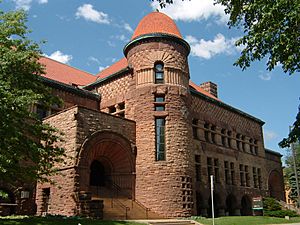
One of the first things the Minnesota Legislature did in 1858 was create a teacher training school in Winona. Minnesota's focus on education has led to a well-educated population. In 2009, Minnesota had the second-highest percentage of high school graduates. About 91.5% of people 25 and older had a high school diploma. It also had the tenth-highest percentage of people with bachelor's degrees. In 2015, Minneapolis was named the nation's "Most Literate City." St. Paul was fourth.
A 2013 study compared eighth-grade students around the world in math and science. Minnesota ranked eighth globally and third in the U.S. In 2014, Minnesota students had the tenth-highest average score on the ACT exam.
The state supports many public universities and colleges. This includes 37 schools in the Minnesota State Colleges and Universities System. It also has five main campuses of the University of Minnesota system. There are also over 20 private colleges and universities. Six of these are ranked among the nation's top 100 liberal arts colleges.
Images for kids
-
Sculpture of St. Urho in Menahga, Minnesota, in 2020
See also
 In Spanish: Minnesota para niños
In Spanish: Minnesota para niños



